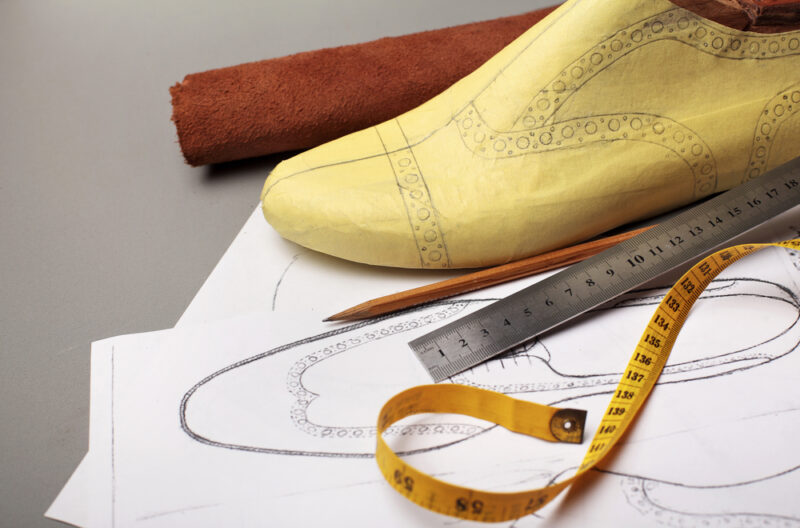Footwear is intended to serve a simple purpose: to protect the feet from the extremities. Yet, footwear design is a complicated process. Aside from protecting feet, shoes need to meet the aesthetic needs of the user as well as provide comfort. Interestingly, many people can’t even describe why they feel connected to a particular pair of shoes. Somehow, they just feel it. As a shoe designer, you’ll need to master the design process to successfully appeal to this basic human intuition.
In This Post
Creating a Concept
The first step in shoe design is to take a step back from the design process itself. Before you can design footwear, you need to come up with a purpose and defining feature of the product. Most professors presiding over graduate programs in fashion refer to this as the conceptualization stage. Try not to think about what the footwear should look like. Instead, brainstorm about why you want someone to be attracted to these shoes.
For example, will they provide durability at an extremely affordable price? Or will they utilize fine, unique materials to be sold at a premium price? Alternatively, some designers opt for styles that will be timeless classics sought after by fervent sneaker collectors.
One main part of research concerns investigating current trends. Some designers choose to go with expensive forecasting services to determine the latest trends. However, you can perform a trend analysis on your own by comparing this year’s styles to those of last year. In general, the colors, materials, and shaping of the current fashion season will differ from the previous one. Notice this distinction to help you pick up on upcoming trends.
Deciding on Materials and Color Schemes
Anyone who wants to be a designer can’t wait to get to this stage. It is exciting to be able to choose whatever you want and try to combine it all together in a single product presentation. However, although this is the most enjoyable process of shoe designing, it can also be the most stressful and time-consuming. A general rule of thumb is to use base colors (such as black gray or brown) and combine them with more vibrant hues that represent the trends in the industry. Do the same with your choice of materials. Use popular or common materials, such as leather or suede, and combine them with new, fresh fabrics and plastics. Most designers with experience will tell you that less is more when it comes to creating an appealing look.
Proper Use of Inspirational Sources
While you are deciding on your colors and materials don’t forget about the shoes that inspire you in the first place. It is a good idea to create an inspiration board where you can place the different styles of shoes you want to emulate. You can also add other sources of inspiration such as sporting uses, celebrity trends, or everyday objects that you want to incorporate into your creation.
The Sketching Process
Sketches are perhaps the most important part the design process. A proper sketch communicates the vision you have in your mind to others. Every good designer needs to be an excellent sketcher. To simply put it, sketching and designing go hand in hand. Once your drawing skills mature, you should be able to create sketches on the spot within a few minutes. During the design process, you can expect to create an endless amount of sketches until you get to the style that has the right feel and look.
Getting Down to Designing
Towards the end of your design process, you will use all of the information you’ve obtained to create your final piece of work. It’s not uncommon to come up with several designs for one pair of shoes. Again, sketching is critically important at this stage. You’ll likely need to modify your design over and over again until it flows well.
There are several different considerations to remember in shoe designing. Every line and curve of the shoe must serve an important purpose. Remember to include your ideas for the stitching, the sole, upper and bottom materials, pattern lines, textures and color schemes. You also need to consider finishes on the edges, the seams, and the lacing pattern. Again, refer back to your initial research to generate ideas. Furthermore, think about the things that your competitors have tried, and try to make them more appealing or usable for the end client.
The Technical Drawing Stage
After you have come up with some winning designs you’ll need to send them to a factory to create prototypes. This can be a difficult process because your styling can get lost in the translation. Therefore, you’ll need to create technical drawings that are very detailed and contain accurate measurements. You’ll know your drawing is complete when there are no questions about the small details. The factory should be able to create a complete shoe without having to consult you for missing information.
Technical drawings need to be done from a 360° perspective. They should also include accurate representations of the colors and materials that should be applied. In most cases, this process will need to be repeated. This could be due to an improper rendering by the factory, or a decision on your part to change elements that look different in real life than they do in drawings.
Putting It All Together
Designing a shoe is a comprehensive process. Don’t expect it to be quick or easy. Yet, if you take the time to consider all the factors that go into creating an attractive, functioning shoe, you will be on the right track. The most important thing to remember is to avoid becoming frustrated or dismayed during the design process. As stated above, you will go through numerous designs before finding the right one. Let the creative process take its course, and you will end up with a final product you can be proud of.
